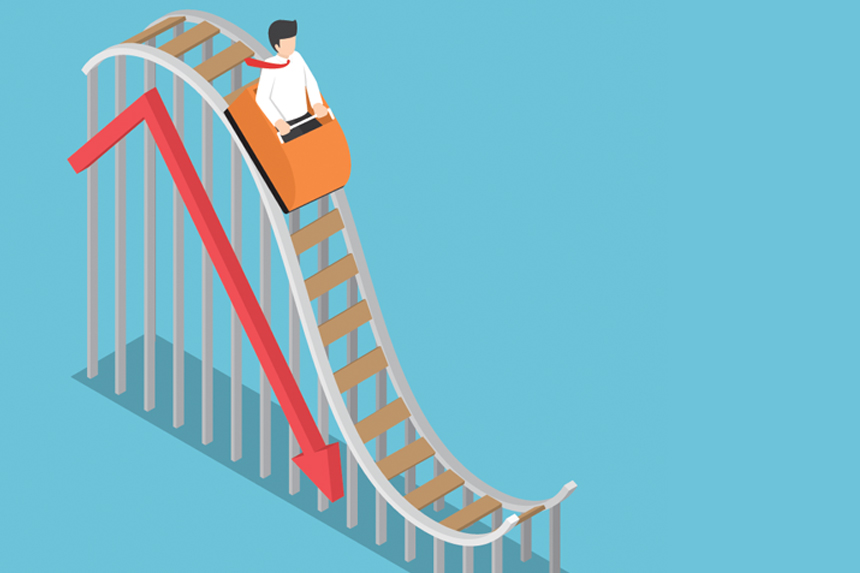On Halloween in 2008, about six weeks after Lehman Brothers collapsed, my mother called from Michigan to tell me that my father had lost his job in the sales department of Visteon, an auto parts supplier for Ford. Two months later, my mother lost her own job working for the city of Troy, a suburb about half an hour from Detroit. From there, our lives seemed to accelerate, the terrible events compounding fast enough to elude immediate understanding. By June, my parents, unable to find any work in the state where they spent their entire lives, moved to New York, where my sister and I were both in school. A month later, the mortgage on my childhood home went into default for lack of payment.
After several months of unemployment, my mother got a job in New York City fundraising for a children’s choir. In the summer of 2010, I completed school at New York University, where I received a B.A. and an M.A. in English literature, with more than $100,000 of debt, for which my father was a cosigner. By this time, my father was still unemployed, and my mother had been diagnosed with an aggressive form of breast cancer. She continued working, though her employer was clearly perturbed that she’d have to take off every Friday for chemotherapy. To compensate for the lost time, on Mondays she rode early buses into the city from the Bronx, where, after months of harrowing uncertainty, my parents had settled. She wanted to be in the office first thing.
In January 2011, Chase Bank took full possession of the house in Michigan. Our last ties were severed by an email my father received from the realtor, who had tried and failed to short sell the property, telling him “it’s safe to turn off the utilities.” In May, I got a freelance contract with a newspaper that within a year would hire me full-time — paying me, after taxes, roughly $900 every two weeks. In September 2011, my parents were approved for Chapter 7 bankruptcy, and in October, due to a paperwork snafu, their car was repossessed in the middle of the night by creditors. Meanwhile, the payments for my debt — which had been borrowed from a variety of federal and private lenders, most prominently Citibank — totaled about $1,100 a month.
I would look at the number on my paycheck and obsessively subtract my rent, the cost of a carton of eggs and a can of beans, and the price of a loan payment.
Now 30 years old, I have been incapacitated by debt for a decade. The delicate balancing act my family and I perform in order to make a payment each month has become the organizing principle of our lives. To this end, I am just one of about 44 million borrowers in the United States who owe a total of roughly $1.4 trillion in student loan debt. This number is almost incomprehensibly high, and yet it continues to increase with no sign of stopping. Reform legislation that might help families in financial hardship has failed in Congress. A bill introduced in May 2017, the Discharge Student Loans in Bankruptcy Act, which would undo changes made to the bankruptcy code in the early 2000s, stalled in committee. Despite all evidence that student loan debt is a national crisis, the majority of the U.S. government — the only party with the power to resolve the problem — refuses to acknowledge its severity.
My debt was the result, in equal measure, of a chain of rotten luck and a system that is an abject failure by design. My parents never lived extravagantly. In the first years of their marriage, my father drove a cab. When they had children and my father started a career in the auto industry, we became firmly middle class. Still, there was usually just enough money to cover the bills — car leases, a mortgage, groceries. My sister and I both attended public school. How much things cost was a constant discussion. Freshman year of high school, when I lost my yearbook, which cost $40, my mother very nearly wept. College, which cost roughly $50,000 a year, was the only time that money did not seem to matter. “We’ll find a way to pay for it,” my parents said repeatedly. And if we couldn’t pay for it immediately, there was always a bank somewhere willing to give us a loan. This was true even after my parents had both lost their jobs amidst a global financial meltdown. Like many well-meaning but misguided baby boomers, neither of my parents received an elite education, but they nevertheless believed that an expensive school was the key to a better life than the one they’d had. They continued to put faith in this falsehood, and so we continued spending money that we didn’t have — money that banks kept giving to us.
I’ve spent a great deal of time in the last decade shifting the blame for my debt. Whose fault was it? My devoted parents, for encouraging me to attend a school they couldn’t afford? The banks, which should never have lent money to people who clearly couldn’t pay it back, continuously exploiting the hope of families like mine, and quick to exploit us further once that hope disappeared? Or was it my fault for not having the foresight to realize it was a mistake to spend roughly $200,000 on a school where, in order to get my degree, I kept a journal about reading Virginia Woolf? The problem, I think, runs deeper than blame. The foundational myth of an entire generation of Americans was the false promise that education was priceless — that its value was above or beyond its cost.
After the dust settled on the collapse of the economy, we found ourselves in an impossible situation: We owed more each month than we could collectively pay. And so we wrote letters to Citibank’s mysterious P.O. box address in Sioux Falls, South Dakota, begging for help, letters that I doubt ever met a human being. The letters began to comprise a diary for my father in particular, a way to communicate a private anguish that he mostly bottled up. In one letter, addressed “Dear Citi,” he pleaded for a longer-term plan with lower monthly payments. He described how my mother’s mounting medical bills, as well as Chase Bank’s collection on our foreclosed home, had forced the family into bankruptcy, which provided no protection in the case of private student loans. We were not asking, in the end, for relief or forgiveness, but merely to pay them an amount we could still barely afford. “This is an appeal to Citi asking you to work with us on this loan,” he wrote to no one at all.
Finally, at the beginning of 2012, my father started writing to the office of Congressman Joseph Crowley, who represented the district in the Bronx where my parents had relocated. My father described himself and my mother to Crowley as “the poster children for this entire financial event,” by which he meant Americans who seemed to have done everything right on paper, but in doing so contributed to their own downfall. By the time he wrote to Crowley, my father was working again, but it had taken him two years to find another job for much less money. After his run of financial calamity, he knew better than to believe anything good would last. “We are in our 60s and I figure when we get to our mid-70s, life will become difficult again,” he wrote.

Crowley’s office wrote back. It was the first time in about two years that a person had responded to our correspondence with encouragement, or something like it. Kevin Casey, who worked for Crowley in Washington, helped arrange a conference call with government liaisons from Citigroup to discuss a different payment plan. The terms were reasonable enough, but the response was like an automated message brought to life: “We are precluded from a regulatory perspective from being able to do what you are asking,” each of the representatives said. What made these exchanges more ridiculous was the fact that Citibank was in the process of retreating from the student loan market by selling off my debt to Discover Financial, who would give us the same response. We were nothing to these companies but a number in a database.
I used to wonder what the people who worked for these lenders would do if their own children had to take out loans to pay for college. After 10 years, I have come to think of my debt as being like an alcoholic relative who shows up to ruin happy occasions. But when I first got out of school and the reality of how much money I owed finally struck me, the debt was more of a constant and explicit preoccupation, a matter of life and death.
I had studied English because I wanted to be a writer. I never had an expectation of becoming rich. My M.A. fed an intellectual curiosity that eventually led me to newspapers. I understand now the extent to which I was among the most overeducated group of young adults in human history. Once I could no longer delay and the payments began, I would look at the number on my paycheck and obsessively subtract my rent, the cost of a carton of eggs and a can of beans (my sustenance during the first lean year of this mess), and the price of a loan payment. The question was: What will you do when the money from the paycheck is gone?
I never arrived at an answer to this question. At my lowest points, I began fantasizing about dying, not because I was suicidal, but because death would have meant relief from having to come up with an answer. The debt was mind-controlling — how I would eat or pay my rent without defaulting was a constant refrain, and I had long since abandoned any hope for a future in which I had a meaningful line of credit or a disposable income or even simply owned something — but also mind-numbingly banal. I spent a great deal of time filling out paperwork over and over again with my personal information and waiting on hold for extended periods in order to speak to a robotic voice rejecting my request.
And so it felt good to think about dying, in the way that it felt good to take a long nap in order to not be conscious for a while. These thoughts culminated in November 2010, when I met with my father one afternoon to retrieve more paperwork. My hope for some forgiving demise had resulted in my being viciously sick with strep throat. I refused to go to the doctor in the hope that my condition might worsen into a more serious infection that, even if it didn’t kill me, might force someone to at last lavish me with pity. I coughed up a not insignificant portion of yellowish fluid, and I started the conversation by asking, “Theoretically, if I were to, say, kill myself, what would happen to the debt?”
“I would have to pay it myself,” my father said. He paused and then offered me a melancholy smile. “Listen, it’s just debt,” he said. “No one is dying from this.”
My father had suffered in the previous two years. In a matter of months, he had lost everything he had worked most of his adult life to achieve — first his career, then his home, then his dignity. He had become a 60-year-old man who had quite reluctantly shaved his graying 40-year-old mustache in order to look younger, shuffling between failed job interviews where he was often told he had “too much experience.” He was ultimately forced out of the life he’d known, dragging with him, like some 21st-century Pa Joad, a U-Haul trailer crammed with family possessions, including, at the insistence of my mother, large plastic tubs of my childhood action figures.
Throughout this misery, my father had reacted with what I suddenly realized was stoicism, but which I had long mistaken for indifference. This misunderstanding was due in part to my mother, who had perhaps suffered most of all. Not that it was a competition, but if it were, I think she would have taken some small amount of satisfaction in winning it. The loss of home and finances felt at least like a worthy opponent for cancer, and yet here was my father telling me that none of this was the end of the world. I was ashamed of my selfishness. The lump in my throat began to feel less infectious than lachrymal. “Okay,” I said to him. When I got home I scheduled an appointment with a doctor.
“Theoretically, if I were to, say, kill myself, what would happen to the debt?” I asked.
Much of the dilemma about being in debt came down to numbers that I could only comprehend in the abstract. $38,840 at 2.25 percent interest, and a notice that in May 2016, the interest would increase to 2.5 percent. A $25,000 loan at 7.5 percent interest, to which my family and I had contributed, over the course of three years, $12,531.12 and on which I now owed $25,933.66 — more than what I started out with. I memorized — or, more often, didn’t — seemingly crucial details about my debt that turned out to be comically meaningless: a low-interest loan from Perkins was serviced by a company called ACS, which had rebranded to Conduent Education and sent out notices with their new logo and the message “Soon to be Conduent.” Citibank, referring to itself as “Citibank, N.A. (Citibank),” transferred the servicing of my loans to Firstmark, and I had to create an account with Firstmark. Sallie Mae’s lending arm spun off into an independent company called Navient, which became the country’s largest supplier of private student loans, and eventually sold a portion of my debt to a lender called Great Lakes. In 2017, the Consumer Financial Protection Bureau sued Navient for deliberately creating problems for borrowers trying to pay off a loan by supplying them with faulty information — for instance, according to the litigation, encouraging borrowers to enter payment plans that temporarily postponed bills instead of enrolling them in repayment plans that promised forgiveness after years of steady payment. This lawsuit seemed bathed in significance, but of course resulted in nothing at all, save for a widely circulated public statement from Navient claiming, “There is no expectation that the servicer will act in the interest of the consumer.” When I received a notice from Navient in February 2017 that my monthly payments would be increasing, for reasons I did not comprehend, the email came with a note at the bottom saying, “We’re here to help: We’re happy to help you navigate your options, provide you with resources, and answer any questions you have as you repay your loans.” The company’s motto is, hilariously, “Solutions for your success.”

These announcements flooded my inbox with the subject line “Important Information,” but none of them altered my fate. Sometimes the monthly payments would go up, sometimes my salary would go up, sometimes I made a check out to a different company. The only stable thing was the money I owed, which never seemed to get any lower. My mother’s cancer went into remission, and both of my parents found, in their 60s, new careers. I maintained steady employment in journalism since finishing school, and in 2016 I was hired as an editor at The New York Times. Was it possible we had become lucky?
It was in the summer of 2017, after my father, now nearing 70, had lost another job, that I finally removed him as a cosigner and refinanced my loans with one of the few companies that provides such a service, SoFi. My wife would help with the payments when she could. Sharing the burden of my debt with my spouse instead of my parents was a small, depressing victory, a milestone perhaps unique to members of my generation.
SoFi has not made my situation much more tenable, necessarily. The main differences are that I now write one check instead of several, and that I have an end date for when the debt, including the calculated interest — about $182,000 — will be paid off: 2032, when I’ll be 44. What I have to pay each month is still, for the most part, more than I am able to afford. I rely on the help of people I love and live by each paycheck. I still harbor anxiety about the bad things that could befall me should the paycheck disappear.
But the so-called Important Information I receive has changed. SoFi, which bills itself as a “modern finance company” (its name is shorthand for Social Finance, Inc.), is a Silicon Valley startup that offers, in addition to loans, membership outreach in the form of financial literacy workshops and free dinners. Their aim is to “empower our members,” a mission that was called into question by the resignation, in September 2017, of its CEO, who employees allege had engaged in serial workplace sexual harassment and who ran the office, according to a New York Times headline, like “a frat house.” The news came out not long after I refinanced my loans with the company — I became, I suppose, a SoFi’er, in the company’s parlance. Around this same time, I started receiving curious emails from them: “Dear NYC SoFi’er,” one of these emails read. “Grab a single friend and join us for a fun night at Rare View Rooftop Bar and Lounge in Murray Hill! You’ll mingle with some of our most interesting (and available!) members …” The invitation cited a statistic that promised “86 percent of members at other SoFi Singles events said they met someone they want to see again.”
I am a 30-year-old married man with more than $100,000 of debt, who makes less each year than what he owes. Buying a pair of pants is a major financial decision for me. I do not think myself “eligible” in any sense of the word. Still, I felt as if in 10 years, the debt hadn’t changed, but the world had, or at least the world’s view of it. This thing, this 21st-century blight, was now so normal — so basic — that it had been co-opted by the wellness industry of Silicon Valley. My debt was now approachable, a way to meet people. It was, in other words, an investment in my future, which is why I had gone into debt in the first place. Would SoFi be this friendly if I lost my job and missed a monthly payment?
Let’s say I was morbidly intrigued. The day after Valentine’s Day, I went to a Mexican restaurant for a SoFi community dinner — this was not a single’s event, but simply a free meal. SoFi had rented out the back room, where a few dozen people had gathered, all wearing name tags and discussing financial woes. Sid, a software developer who had racked up credit card debt after college, told me that the debt was a unifying force at these gatherings. “When there’s a break in the conversation, someone can just say, ‘So, debt, huh?’ and things will get going again,” he said. “If we walked outside of this room,” he continued, gesturing to the suits by the bar, “everyone out there would have debt, too. It’s just a little more out in the open for us.”
Despite the name tags, the dinner turned out to resemble something more like an AA meeting, an earnest session of group therapy. Everyone had their story about the problems caused by their student loans and how they were trying, one day at a time, to improve things, and no story was exceptional, including my own. Ian, an employee for Google who had recently successfully paid off his debt from a Columbia MBA program, said he had a few “bone dry” years, where he lived on instant noodles. I told him I had a long way to go. “At least you’re doing something about it,” he said, sincerely.
We sat down to dinner. Across from me was Mira, a defense attorney who attended law school at Stanford. Her payments amount to $2,300 a month, more than double my own. When I asked her why she came to this event, she glanced at me as if the answer should have been obvious: She went to law school at Stanford, and her payments are $2,300 a month. After the food was served, a waiter came by with a stack of to-go boxes. The group was reluctant at first, but then Ian said, “The chicken was actually pretty good,” as he scooped it into one of the boxes. Mira shrugged, took a fork, and added, “This is a little tacky, but I’d hate to waste free food,” and the rest of the table followed her lead. Maybe the next generation will do better, but I felt like we were broke and broken. No number of degrees or professional successes would put us back together again. For now, though, we knew where our next meal was coming from.
M.H. Miller is the arts editor for T: The New York Times Style Magazine.
This article is from the January/February 2019 issue of The Saturday Evening Post. Subscribe to the magazine for more art, inspiring stories, fiction, humor, and features from our archives.
Become a Saturday Evening Post member and enjoy unlimited access. Subscribe now




Comments
A timely and personal article by Mr. Miller, a fellow millennial, on how the Great Recession not only sent shockwaves throughout America (and beyond) by taking a hit to the economy, but also managed to have long-term social and cultural ramifications as well. Boomers (and to a lesser extent, Gen X) racked up a gambling bill they couldn’t begin to pay — and left Millennials and Gen Z with the tab. A new generation of citizens in a “flourishing” job market of minimum-wage part-time jobs, crushing debt, with little to no savings, condemned to be full-time apartment renters rather than optimistic home-owners as a direct result of the havoc that the GR left in its wake.
And now, with the Trump administration, we’re looking to a dim future of continual, if not worse, substandard of living unless things change drastically for the better.
Btw, this article (along with the two others concerning the GR) should’ve been the cover story of the Jan/Feb 2019 issue. But instead we got ice… What’s with that?
How sad.how true. We need to rid ourselves of ALL politicians and start over
These stories always amuse me because they are so one-sided. It’s like asking someone why they’re divorced, always the other person’s fault. I didn’t see anything about this man’s ever having any kind of job while in college, and a degree in English Lit was probably a poor choice in the first place.
I’m pretty sure student loans cannot be wiped out in bankruptcy for a good reason. Unlike an automobile, a lender cannot repossess your education. Students would automatically declare bankruptcy after receiving their degree. Before long, student loans would then become nonexistent.
If the Democratic Party can squelch its obsession with identity and sexual politics ( the culture war is over, and, whether one likes it or not, the radical Left has won ), and begin to deprecate Wall Street, and argue for the economic interests of the other 90% of the population, it has the potential in 2020 for the most devastating political landslide in American history.
I was in WA state during this time. I was keeping tabs on rental units in 2010 due to impending dissolution of marriage. I noticed a lot of neighbors lost their middle-class homes. Nothing fancy, just 1400 Sq Ft homes for young, growing families. I kept track of apartment and rental home. Single-family houses were scarce in the rental market in Snohomish County outside of problematic areas of Everett––drug territory. Apartment rent was climbing.
As rent in apartments began to slow down the one apartment in Monroe we had lived at in 1993 rose from $795 to $1,095 in the 2 year period. Suddenly, there were numerous single-family homes for rent from Real Estate Management companies. I wondered about that until I ran across a webpage while looking for something else in 2013.
I found a timeline of the ups and downs of various stocks in the stock market. One of them read: “Rental Property Stocks.” Was it a coincidence this particular stock begun to plummet in 2004, and well paying jobs had been shipped overseas shortly following the enactment of WTO (World Trade Organization)? I have serious doubts.
No wonder my neighbor’s pristinely kept, a move-in ready home, was never put on the market to sell (nor most of the others) after they willingly handed it back to the bank when the husband lost his job. This family of six moved into a low-rent range apartment in the next town.
It’s a shame so many politicians can’t figure out why so many Americans today are angry, as they and their corporate buddies pile more and more money into their storage-houses.